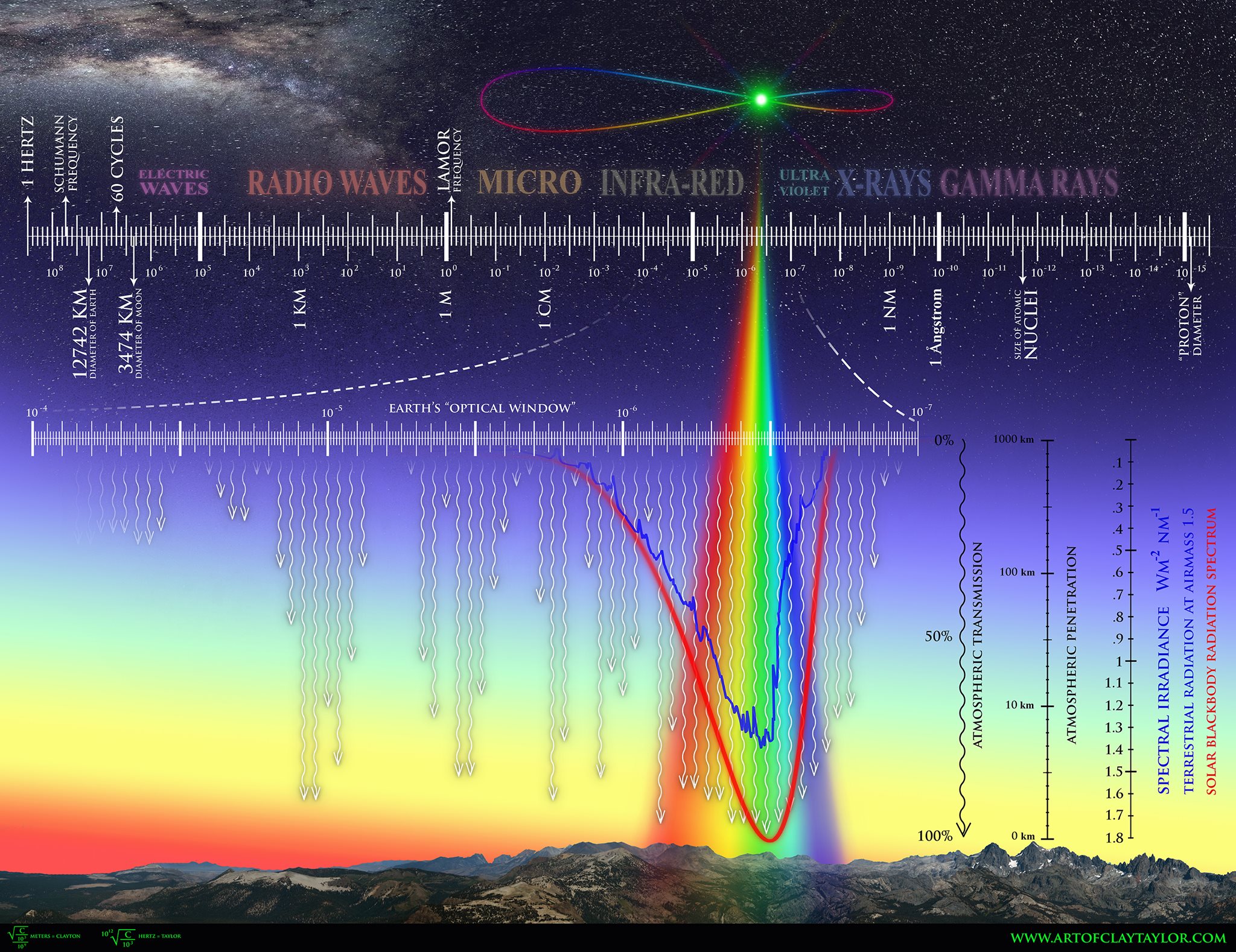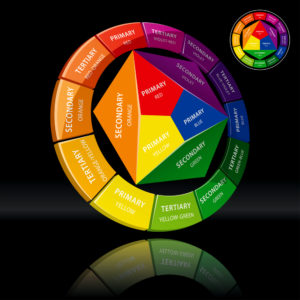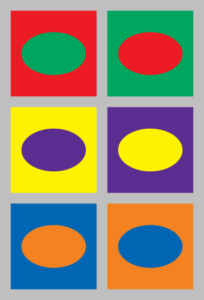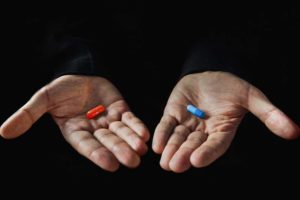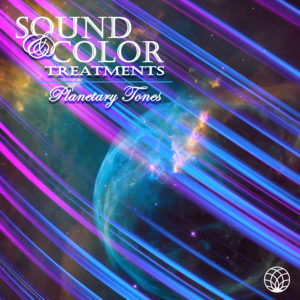 What if you could strengthen your immune system, improve your mood, eliminate anxiety, become more present or even cure diseases by simply using color? Research in the fields of Chromotherapy and Color Psychology have suggested just that. The concept of using color to heal the body is a centuries old idea. Treatment methods have been developed that correlate the different systems of the body, states of consciousness and aspects of the personality to specific hues. It’s believed that exposure to certain hues can subtly influence the body-mind, our perceptions and behaviors.
What if you could strengthen your immune system, improve your mood, eliminate anxiety, become more present or even cure diseases by simply using color? Research in the fields of Chromotherapy and Color Psychology have suggested just that. The concept of using color to heal the body is a centuries old idea. Treatment methods have been developed that correlate the different systems of the body, states of consciousness and aspects of the personality to specific hues. It’s believed that exposure to certain hues can subtly influence the body-mind, our perceptions and behaviors.
In this article we explore some of the medical, psychological and spiritual uses of color. By understanding the power of hues we can start to see the world in new and more vivid ways.
Why do we like certain things better than others? What does our favorite color say about what we’re like inside? And how might we use something so ordinary and ubiquitous as hue to make evolutionary leaps toward greater spiritual wholeness? We’ll explore some common and some exceptional uses of color to get you started on your own chromatic journey.
Color Science
Color medicine is as old as every other form of medicine. Phototherapy – meaning light therapy – has been practiced in ancient cultures around the world. The Egyptians, who venerated the sun god Ra, used sunlight as well as color for healing. The “Nei Ching”, the oldest known book of internal medicine, lists a series of color treatments. Hypocrities, Aristotle, Plato and Pythagorus also studied color seeking to uncover its secrets. Issac Newton demonstrated that all colors are present in white light in his famous paper entitled “Optiks”, generating scientific interest in the nature of color and light.
Today medical professionals commonly use blue light therapy in a number of ways, from treating sun damaged skin, acne, depression, and accelerating the healing process after surgery. Some doctors have even been known to use blue light rooms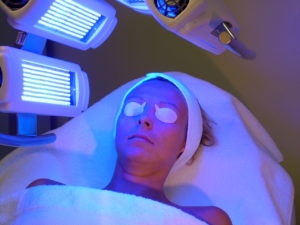 designed for patients to eliminate fatigue during long shifts, since blue light has been shown to decrease drowsiness in certain dosages. Light has been shown to be effective in treating SAD (seasonal affect disorder), which causes depression during winter months where people aren’t able to go outside to get any sunlight. Sunlight, or the lack of it, can have a significant impact on our psychology and bio-chemistry.
designed for patients to eliminate fatigue during long shifts, since blue light has been shown to decrease drowsiness in certain dosages. Light has been shown to be effective in treating SAD (seasonal affect disorder), which causes depression during winter months where people aren’t able to go outside to get any sunlight. Sunlight, or the lack of it, can have a significant impact on our psychology and bio-chemistry.
In color psychology researchers explore how certain hues effect human behavior and emotions. These insights get applied regularly in ways that often go unannounced and unnoticed. The design and film industries, marketing and architecture are all fields that take into account the emotional and psychological power hues have on us. While product designers, artists and filmmakers use color palettes in order to increase the effectiveness of the mood they’re setting, public schools will often paint classrooms with the emotional impact of color in mind. It’s believed that soft yellow creates an uplifting mood, increases creativity and attentiveness, and blue light eliminates fatigue and encourages positivity.
In marketing, color is considered to be a critical element in shaping consumer’s perceptions of goods and services. Victoria’s Secret uses pink in its branding to convey femininity, while Target, and countless fast-food chains and corporate brands use red to stimulate the urgency of desire. Research shows that warm colors tend to improve spending even though cooler colors are considered preferable by most people. It’s also been shown that packaged foods sell better when they contain more green, suggesting subconsciously to consumers that the product is healthy, as if to imply the presence of leafy greens. Drug manufacturers also use color to influence perception. It’s been shown that the color of a pill can influence the effectiveness of placebos. Red and orange pills, for example, are often used for stimulants.
Most of color’s impact on us is beneath our threshold of conscious awareness or is largely subconscious and non-rational. We immediately receive a feeling about something just by its hue. This is because we evolved with nature, learning its innate color language. In nature, color communicates the qualities of organisms. Plants, animals and even insects use color as a way to ward off predators, attract mates, propagate seeds and attract pollinators. Fruits and vegetables are brightly colored to encourage creatures to come eat them. A bright red apple in a field of green is a powerful signal. Having a bright color gives it an evolutionary advantage that helps it propagate. When a fruit is eaten, its seeds have an opportunity spread.
Millions of years of evolution of the rods and cones of the eye co-evolving with a variety of organisms have developed into a profound relationship between humans and the natural language of color. This relationship touches every aspect of our lives. To gain a conscious understanding of this natural language can help us navigate our perceptions and emotions more skillfully. Hue can account for a large portion of our attractions and aversions toward things. It influences why we choose one product over another, one outfit over another, how our likes and dislikes are stored inside our brains, and what subtle signals things can communicate to us without noticing consciously.
What is Color?
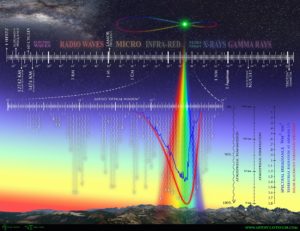 Insights from the physics of electromagnetism show that color (visible light) takes up a certain bandwidth in the electromagnetic spectrum. From radio waves to microwaves to infrared light, to visible light, ultraviolet light, x-rays and gamma rays, the entire spectrum of EM radiation is a gradient of oscillating wave forms. Visible light, where hues live, is right around the golden ratio point on the spectrum. Each bandwidth or category of EM radiation is made of the same essential substance but have different effects and uses depending on their rate of vibration. Audible sound also shares the same wave dynamics of the EM radiation, leading many theorists to connect color to sound as two different vibratory octaves of the same essential activity.
Insights from the physics of electromagnetism show that color (visible light) takes up a certain bandwidth in the electromagnetic spectrum. From radio waves to microwaves to infrared light, to visible light, ultraviolet light, x-rays and gamma rays, the entire spectrum of EM radiation is a gradient of oscillating wave forms. Visible light, where hues live, is right around the golden ratio point on the spectrum. Each bandwidth or category of EM radiation is made of the same essential substance but have different effects and uses depending on their rate of vibration. Audible sound also shares the same wave dynamics of the EM radiation, leading many theorists to connect color to sound as two different vibratory octaves of the same essential activity.
Light and Sound
Sound and color are separated by 40 octaves. This mathematically puts the middle C at green, D at light blue, and so on up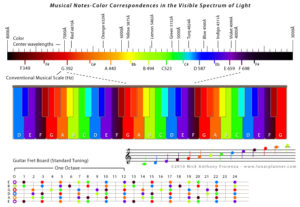 the spectrum. In the mystery traditions however, C is assigned to red, D to orange and so on. The major difference here is one where the mathematical version presents the complimentary colors of the esoteric correspondences. By the RYB model, Red/Green, Orange/Blue, Yellow/Purple, are the complimentary colors. Another way to think of the connection between the mathematical and esoteric correspondences between color and sound is through the interval of the fifth in music theory. The interval of the fifth 3:2 is considered the most harmonious interval apart from the 1:1 octave ratio. In the C major scale, for example, the most harmonious note is G, so here we have the complimentary colors Red and Green harmonizing in the same scale at the fifth.
the spectrum. In the mystery traditions however, C is assigned to red, D to orange and so on. The major difference here is one where the mathematical version presents the complimentary colors of the esoteric correspondences. By the RYB model, Red/Green, Orange/Blue, Yellow/Purple, are the complimentary colors. Another way to think of the connection between the mathematical and esoteric correspondences between color and sound is through the interval of the fifth in music theory. The interval of the fifth 3:2 is considered the most harmonious interval apart from the 1:1 octave ratio. In the C major scale, for example, the most harmonious note is G, so here we have the complimentary colors Red and Green harmonizing in the same scale at the fifth.
Thinking of color and sound correspondences allows us to use our sensory associations in a powerful way. In connecting the visual domain to the aural domain, we are combining sensory perceptions that would otherwise be separated. But all things are joined, everything is connected as all things come from One Thing. Yet it’s our sense perceptions that make things appear to us as separate, divided and unrelated. Associating hue to pitch then begins to develop in us a kind of intentional synesthesia that trains the mind to find similarities between things with different apparent qualities. Ultimately this empowers our ability to recognize the archetypal level of meaning, helping us to see into the essential nature of things rather than just their surface appearances.
Over time this strengthens a synthesis awareness that is profoundly integrative, not only helping us to see innate similarities, but showing us how those similarities stem from an essential unity that transcends their apparent distinctions. It’s this capacity that allows the mind to apprehend the numinous, to reveal deeper layers of the great mystery, making apparent how the arcane is embodied in the mundane.
“This is your last chance. After this there is no turning back. You take the blue pill: the story ends, you wake up in your bed and believe whatever you want to believe. You take the red pill: you stay in Wonderland and I show you how deep the rabbit hole goes.” – Morpheus, The Matrix
Hue and pitch are perhaps one of the most accessible and illuminating demonstrations of the hermetic laws of vibration and 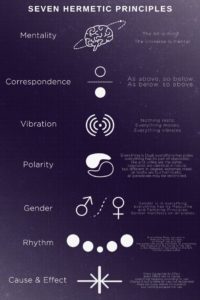 correspondence. At the root of light, sound and electromagnetism is vibratory force, each of which correspond to each other by a matter of octaves. Vibration is the movement or oscillation of energy between two poles. This oscillating motion is symbolically akin to the local motion of a serpent. Vibration underlies the archetypal meaning of the occult idea of the “serpent power”. Whether it’s the Python that was defeated by Apollo at Delphi, the plumed serpent of the Mayan people, Moses’ serpent of wisdom, or the kundalini of the eastern philosophy, the serpent power is representative of our ability to perceive and therefore to be deceived by appearances. In using this force with exceptional skillfulness we can transform the seductive and deceptive aspect of our sensory perceptions into the power of prophecy – meaning the power to see things as they actually are.
correspondence. At the root of light, sound and electromagnetism is vibratory force, each of which correspond to each other by a matter of octaves. Vibration is the movement or oscillation of energy between two poles. This oscillating motion is symbolically akin to the local motion of a serpent. Vibration underlies the archetypal meaning of the occult idea of the “serpent power”. Whether it’s the Python that was defeated by Apollo at Delphi, the plumed serpent of the Mayan people, Moses’ serpent of wisdom, or the kundalini of the eastern philosophy, the serpent power is representative of our ability to perceive and therefore to be deceived by appearances. In using this force with exceptional skillfulness we can transform the seductive and deceptive aspect of our sensory perceptions into the power of prophecy – meaning the power to see things as they actually are.
By seeing into things rather than just their surface appearances, we can perceive the arcane or hidden dimension of everything. We can see that the life-power, the animating principal of consciousness, is the singular substance in which all things live and move and have their being. Throughout all the domains of manifestation, it is only this one universal substance taking form. Each of the various scales and levels of complexity are the octave expressions of the universal life-power in a particular form of specialization.
Everything is Vibration
Insights from physics and neuroscience have corroborated and clarified much of the ancient knowledge of the vibratory nature of existence. We know now that the human body functions on the basis of electro-chemical oscillations. Our subjective states of consciousness correspond with frequency oscillations in the brain and nervous system. We understand now that each of our sense perceptions function on the basis of wavelengths of vibratory oscillations. Our vision can pick up on wavelengths between 400-700 nanometers. Our hearing picks up on the wavelengths between 20hz and 20,000hz. Our sense of touch on wavelengths from 5 to 50 hz. Each of our senses is a kind of vibration receiving station aimed at a particular bandwidth of the EM spectrum. And, once the stimulus has entered in, the brainwaves spark into operation working to decode their meaning.
It’s no surprise then that people would have developed a cosmology that has vibratory force as the main character and essential substance of creation. Combining sound and color to describe aspects of consciousness and the human body is a natural outgrowth of this world view. Light, sound, and electricity are essentially the same in that they propagate through vibratory patterns that we measure in terms of wavelengths. Wavelengths, no matter how fast or slow or what their medium of propagation is, share some common behaviors. They all operate according to the laws of harmonics and resonance. Whether we’re considering hue, frequency, or voltages we are considering different modes of the expression of one thing.
The Archetypal Meaning of Color
 The most widely known system of color – sound correspondences comes from India and the Chakra system. The chakras show the rainbow of colors starting from red at the base of the spine moving up to the color violet at the crown of the head. This model shows the human vehicle as a rainbow with each color representing a particular domain of consciousness and human life. Long before optics, neuroscience and electrical engineering, the wisdom traditions considered consciousness to be electrical and vibratory in nature with each aspect of consciousness being a particular vibratory bandwidth. The use of hue and chants to stimulate the centers of consciousness is commonly practiced as a means of both healing the imbalances of the body-mind and as a means for stimulating latent aspects of consciousness into activity in order to bring about a change in perception.
The most widely known system of color – sound correspondences comes from India and the Chakra system. The chakras show the rainbow of colors starting from red at the base of the spine moving up to the color violet at the crown of the head. This model shows the human vehicle as a rainbow with each color representing a particular domain of consciousness and human life. Long before optics, neuroscience and electrical engineering, the wisdom traditions considered consciousness to be electrical and vibratory in nature with each aspect of consciousness being a particular vibratory bandwidth. The use of hue and chants to stimulate the centers of consciousness is commonly practiced as a means of both healing the imbalances of the body-mind and as a means for stimulating latent aspects of consciousness into activity in order to bring about a change in perception.
In the western mystery tradition, hue is used as a kind of bucket or category system in which many associated chains of ideas can be stored and organized together. Linking associated chains of ideas into color groups allows for a great volume of meaning to be referenced all at once. Constellating ideas together can provide deeper layers of meaning between the ideas they represent, drawing into awareness the more abstract or archetypal level of meaning. For example, imagine the color white. When you think of white you probably think of clouds, snow, a bride’s wedding dress, and so on, all things that have a quality of cleanliness and lightness. This elicits the idea of purity, innocence and goodness.
Another example we can consider is that we all think of green as being representative of nature since the plant kingdom is predominantly green. Green represents the idea of fertility, creativity, nurturing and peace. With nature having provided for us for millions of years, we have even grown to thinking of nature as a mother goddess, linking the color green with our very sustenance. In the mystery tradition our natural tendency of linking of ideas together to convey something larger is used to teach us about how consciousness works, how it moves through the world, and how it grows toward maturity.
In Qabalah, the tree of life shows us its many colored fruits, one white, one grey, one black and seven colors corresponding to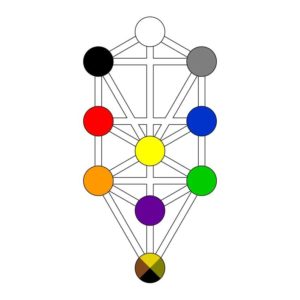 the color spectrum Issac Newton showed when he split white light through a prism into seven hues. Each of these fruits called Sephiroth are considered aspects of consciousness and the divine personality. Each of these centers are referencing a massive volume of information that we could say contain the entirety of the tradition’s curriculum.
the color spectrum Issac Newton showed when he split white light through a prism into seven hues. Each of these fruits called Sephiroth are considered aspects of consciousness and the divine personality. Each of these centers are referencing a massive volume of information that we could say contain the entirety of the tradition’s curriculum.
In the Qabalaistic tradition, the life-power, the essence of livingness itself, and that which gives rise to all things in nature is thought of as undergoing a process of differentiation through the various frequency bandwidths. Much in the same way Newton’s prism sorted out white light into its seven colors, so does the One Life sort itself out into its many forms of expression. First through the primary colors RYB (red, yellow, blue), and then through the secondary or combination colors orange green, purple and violet.
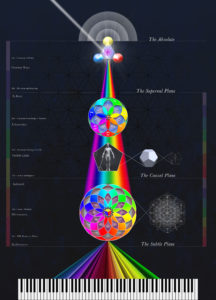 Each hue or sphere then is like a container holding the total meaning of that attribute of the life-power and its particular flavor of expression. The red sphere for example is associated to the idea of strength, the will or power principle. The basic force that governs our will to act is indicated here. Like the red blood that supplies our organs and muscles with the ability to function, the red sphere suggests everything to do with our ability to live and move and produce. The laws of nature and the attributes of consciousness, which operate by the same principals are shown as a set of symbol patterns summed up in a color code.
Each hue or sphere then is like a container holding the total meaning of that attribute of the life-power and its particular flavor of expression. The red sphere for example is associated to the idea of strength, the will or power principle. The basic force that governs our will to act is indicated here. Like the red blood that supplies our organs and muscles with the ability to function, the red sphere suggests everything to do with our ability to live and move and produce. The laws of nature and the attributes of consciousness, which operate by the same principals are shown as a set of symbol patterns summed up in a color code.
Traditionally, this method of organizing and conveying information through a color and symbol code is used as a means of helping the mind to grasp abstract ideas in a more integrated way. When we use a memory training device that functions in the exact same way the mind already links and processes ideas, it becomes very useful for getting across abstract ideas.
The practical applications
We can apply this insight to address specific symptoms in the body-mind. By following the broader meanings represented by the color code into their more physical expression in us, we have a tool to address some of the more subtle issues we deal with in our daily lives. By meditating on specific colors we can stimulate that aspect of our internal psycho-spiritual dimension. Colors can provide us with a kind of medicine that we can use to get at the underlying energetic factors.
If we have a problem with anxiety, looking at the blue for several minutes can bring us to a calm state. If we’re feeling lethargic and unmotivated we can use the color red to get us in gear. As a part of a comprehensive regime for addressing emotional and physical ailments color and sound treatments can be very beneficial. It shouldn’t replace necessary medicines and medical procedures, but as a supplemental treatment it has much to offer in the way of correcting certain energetic imbalances.
Color and sound are powerful tools that can help us heal and evolve spiritually. By developing a conscious connection to the power of color we can dress our lives in ways that support the kinds of energies we want to cultivate. We can attune our consciousness to hues to bring more of its gifts into our lives. If you’d like to experiment with how color therapy can change your life, check our Sound and Color Treatments.
These treatment sessions contain specially tuned music over colored 20-minute videos that correspond to the planetary tones.
Enjoy
Martian Red, Key of C
Solar Orange, Key of D
Mercurial Yellow, Key of E
Venusian Green, Key of F#
Lunar Blue, Key of G#
Saturnian Indigo, Key of A
Jupiterian Violet, Key of B
Download these to your library today and experience the benefits of color on your consciousness.

